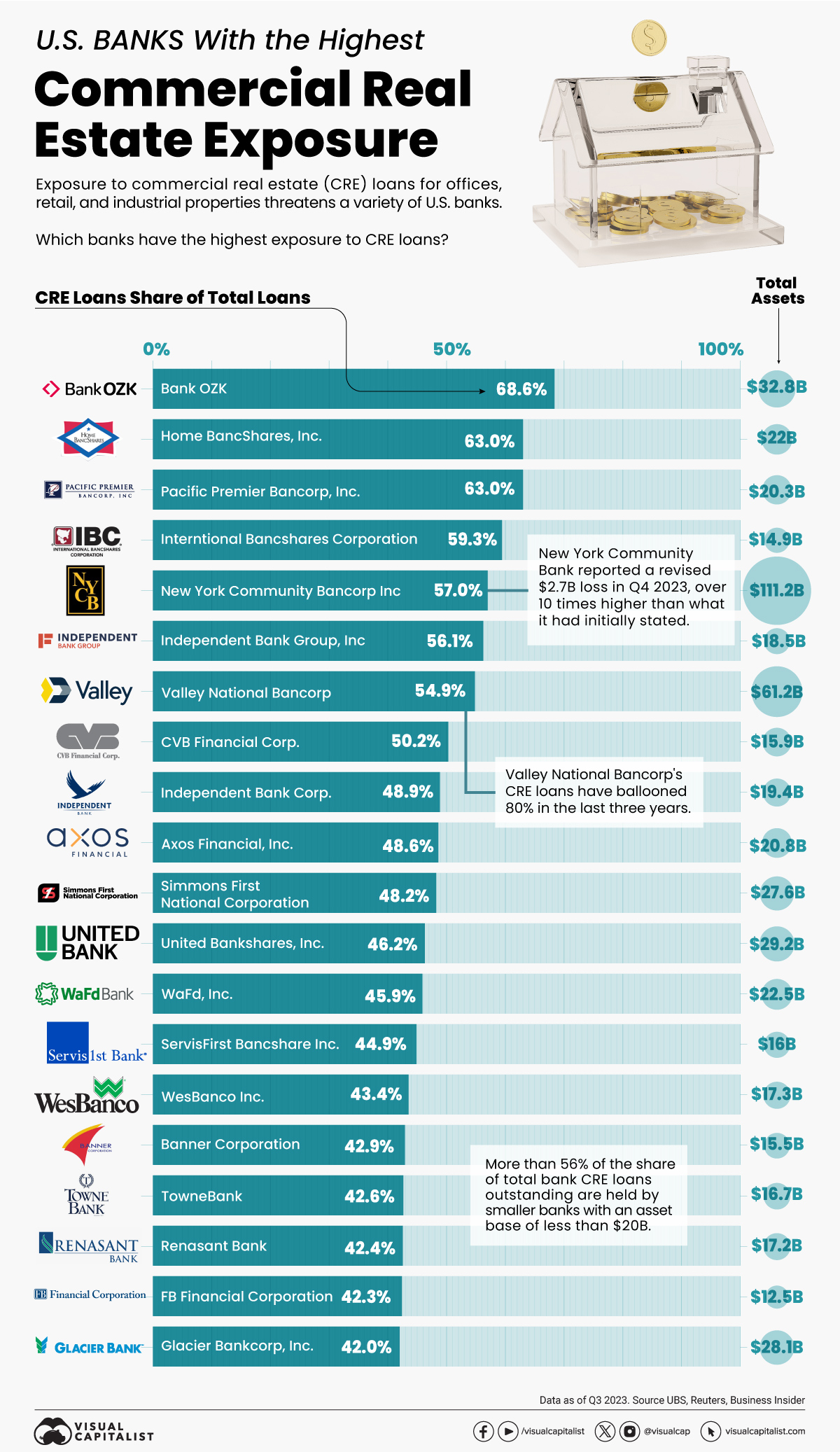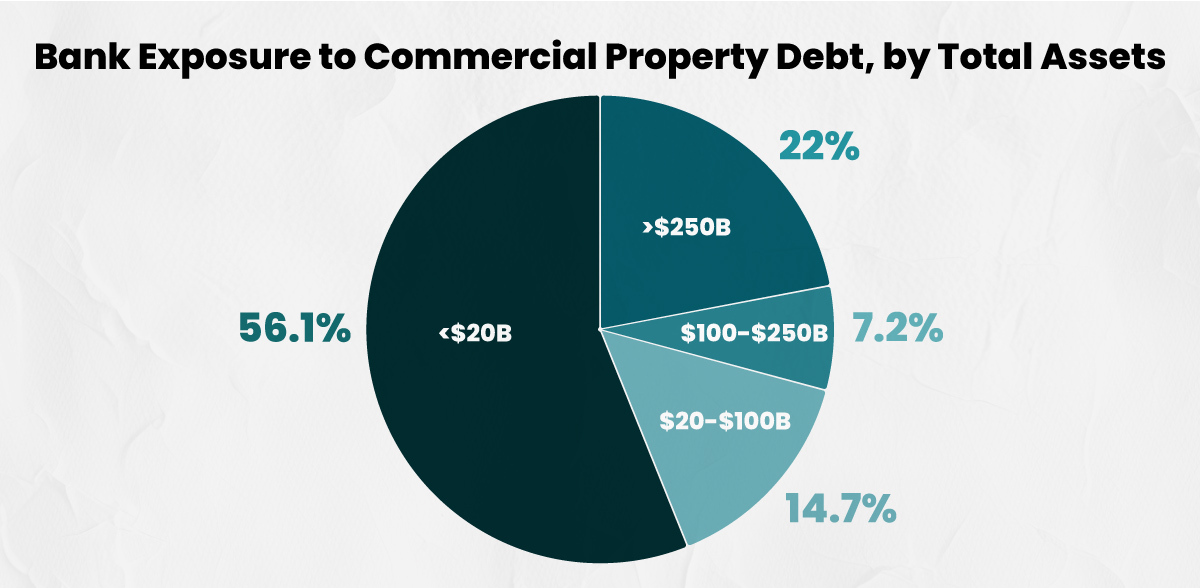![]()
See this visualization first on the Voronoi app.

U.S. Banks With the Most Commercial Real Estate Exposure
This was originally posted on our Voronoi app. Download the app for free on iOS or Android and discover incredible data-driven charts from a variety of trusted sources.
Today, there is roughly $5.7 trillion in commercial real estate debt outstanding—with U.S. banks holding approximately half of this total on their balance sheets.
The commercial property sector, which includes office, retail, healthcare, and multi-family properties, has faced mounting pressures amid high interest rates and lower occupancy levels. Given these headwinds, it poses the risk of higher defaults and steep loan losses in a sector that has not fully recovered since the collapse of Silicon Valley Bank last year.
This graphic shows the U.S. banks with the highest exposure to the commercial real estate sector, based on analysis from UBS.
Top U.S. Banks, by Share of Commercial Property Loans
Here are the banks with the greatest concentration of commercial property loans as of the third quarter of 2023:
| Bank | Commercial Real Estate Share of Total Loans | Total Commercial Real Estate Loans | Total Assets |
|---|---|---|---|
| Bank OZK | 68.6% | $17.4B | $32.8B |
| Home BancShares, Inc. | 63.0% | $9.0B | $22.0B |
| Pacific Premier Bancorp, Inc. | 63.0% | $8.4B | $20.3B |
| International Bancshares Corporation | 59.3% | $4.7B | $14.9B |
| New York Community Bancorp Inc | 57.0% | $49.0B | $111.2B |
| Independent Bank Group, Inc. | 56.1% | $8.0B | $18.5B |
| Valley National Bancorp | 54.9% | $27.5B | $61.2B |
| CVB Financial Corp. | 50.2% | $4.5B | $15.9B |
| Independent Bank Corp. | 48.9% | $7.0B | $19.4B |
| Axos Financial, Inc. | 48.6% | $8.3B | $20.8B |
| Simmons First National Corporation Class A | 48.2% | $8.1B | $27.6B |
| United Bankshares, Inc. | 46.2% | $9.8B | $29.2B |
| WaFd, Inc. | 45.9% | $8.1B | $22.5B |
| ServisFirst Bancshares Inc | 44.9% | $5.2B | $16.0B |
| WesBanco, Inc. | 43.4% | $4.9B | $17.3B |
| Banner Corporation | 42.9% | $4.6B | $15.5B |
| TowneBank | 42.6% | $4.8B | $16.7B |
| Renasant Corporation | 42.4% | $5.3B | $17.2B |
| FB Financial Corporation | 42.3% | $4.0B | $12.5B |
| Glacier Bancorp, Inc. | 42.0% | $6.8B | $28.1B |
As the above table shows, the vast majority of banks with the greatest exposure are small and medium-sized financial institutions.
Bank OZK, based in Arkansas, has the highest proportion of commercial property loans, at 68.6% of total loans. As one of the country’s most prominent lenders to Manhattan property developers, its share price has outperformed the S&P 500 by tenfold since going public 27 years ago.
New York Community Bancorp, the only big bank on the list, has $49 billion in commercial property loans, making up 57% of its overall loans. At the height of regional banking turmoil last year, one of New York Community Bancorp’s subsidiaries took over the failed Signature Bank in a multi-billion dollar deal.
Since the bank reported $2.7 billion in losses in the fourth quarter of 2023, its share price has plummeted roughly 68%. The surprise loss—which was revised from $252 million—prompted the bank to seek a $1 billion lifeline from investors to help shore up confidence in the institution. Former U.S. Treasury Secretary Steven Mnunchin was a major investor in the deal.
Like New York Community Bancorp, a number of other regional banks have seen their share prices lag due to its fallout.
Commercial Property Debt Concentrated in Small Banks
Below, we show how the majority of commercial real estate loans are found in small U.S. banks, which are those with assets of $20 billion and under:

With 56.1% of all commercial property loans, small U.S. banks face the highest risk compared to other bigger banks.
Given the high share of loans, banks may run the risk of failure especially if credit losses accelerate and valuations decline. At the same time, it could be more challenging to refinance debt as valuations deteriorate.
While these troubles have begun to emerge over the last year, there is also the likelihood that losses could continue over the next several years. In fact, after the global financial crisis, credit losses peaked two years after delinquencies hit their highest point.
The post The U.S. Banks With the Highest Exposure to Commercial Real Estate appeared first on Visual Capitalist.